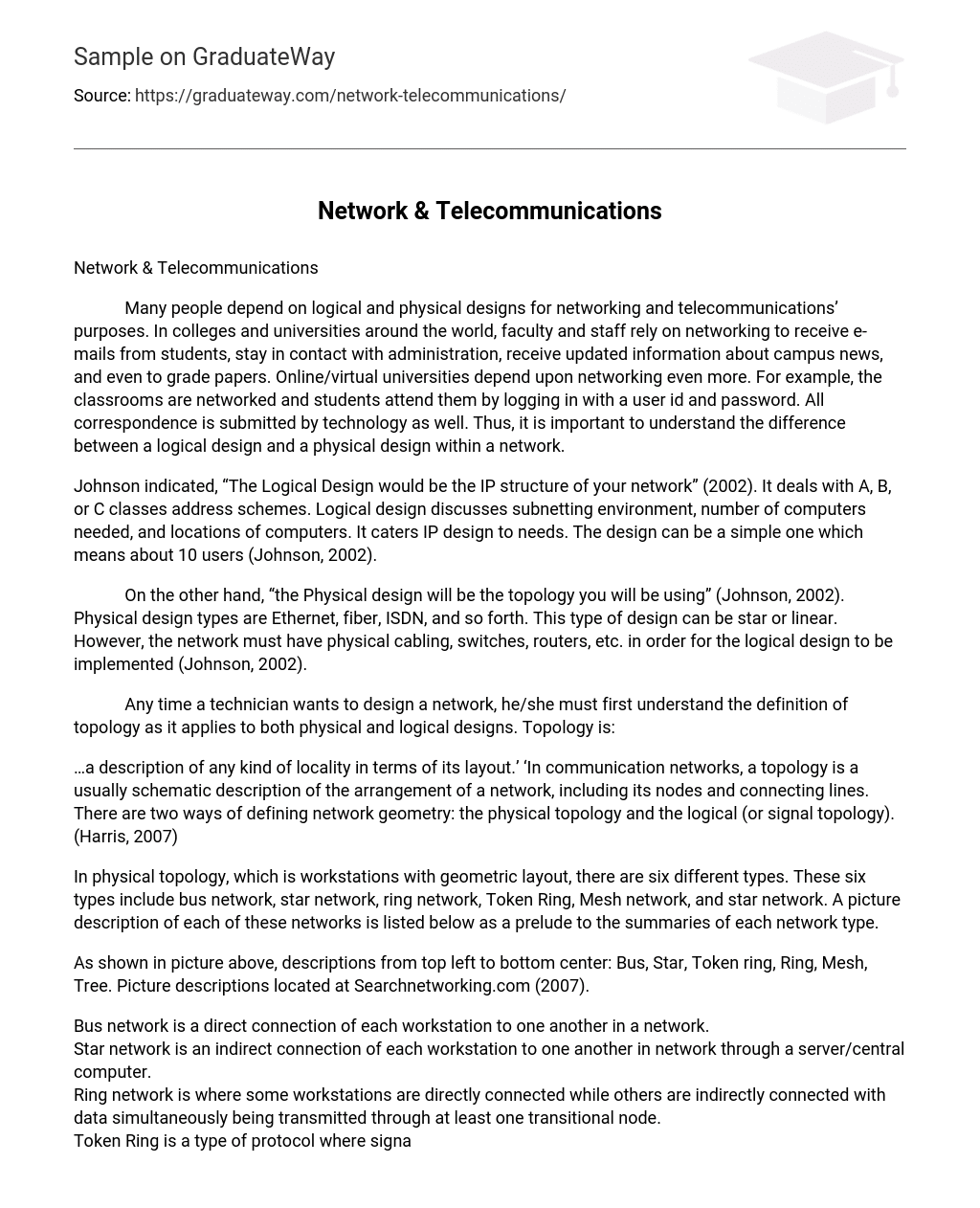Any people depend on logical and physical designs for networking and telecommunications’ purposes. In colleges and universities around the world, faculty and staff rely on networking to receive e-mails from students, stay in contact with administration, receive updated information about campus news, and even to grade papers. Online/virtual universities depend upon networking even more. For example, the classrooms are networked and students attend them by logging in with a user id and password. All correspondence is submitted by technology as well. Thus, it is important to understand the difference between a logical design and a physical design within a network.
Johnson indicated, “The Logical Design would be the IP structure of your network” (2002). It deals with A, B, or C classes address schemes. Logical design discusses subnetting environment, number of computers needed, and locations of computers. It caters IP design to needs. The design can be a simple one which means about 10 users (Johnson, 2002).
On the other hand, “the Physical design will be the topology you will be using” (Johnson, 2002). Physical design types are Ethernet, fiber, ISDN, and so forth. This type of design can be star or linear. However, the network must have physical cabling, switches, routers, etc. in order for the logical design to be implemented (Johnson, 2002).
Any time a technician wants to design a network, he/she must first understand the definition of topology as it applies to both physical and logical designs. Topology is: …a description of any kind of locality in terms of its layout.’ ‘In communication networks, a topology is a usually schematic description of the arrangement of a network, including its nodes and connecting lines. There are two ways of defining network geometry: the physical topology and the logical (or signal topology). (Harris, 2007)
In physical topology, which is workstations with geometric layout, there are six different types. These six types include bus network, star network, ring network, Token Ring, Mesh network, and star network. A picture description of each of these networks is listed below as a prelude to the summaries of each network type.
As shown in picture above, descriptions from top left to bottom center: Bus, Star, Token ring, Ring, Mesh, Tree. Picture descriptions located at Searchnetworking.com (2007).
There are two ways to create a network: design and install a new network or upgrade an existing one. Yet, the technician must first analyze traffic patterns that the design will create. Next, any existing bottlenecks must be located. Then the number of bottlenecks must be reduced whenever applicable. One way to accomplish this is to have two ways to the resources. Another method is to install “…servers that provide replicas of important data so that load balancing can be provided” (Informit Network (QUE), 2003).
- Technicians wishing to design a network must ask themselves many questions and know the answers to them all. QUE (2003) mentioned how the questioning must go:
- Who are the clients? What are their actual needs? How have you determined these needs—from user complaints or from help-desk statistics? Is this data reliable?
- What kinds of services will you provide on the network? Are they limited in scope? Will any involve configuring or firewall between LANs? And if so, that still doesn’t account for configuring a firewall to enable access to the Internet?
- Will you need to allow an Internet connection for just your internal network’s users, or will use you need to allow outside vendors access your network?…(QUE, 2003)
When it is all said and done, the technician should have created a fully operational network. This can be done for colleges and universities that desire to network an e-mail system such as Microsoft Office. It can be done for a cable company to keep track of all users and make sure no one is illegally watching cable. The telephone company can network phone lines for business purposes as well as personal usage where one home/office can have more than one phone.
One way of looking at the telephone networking is to realize that homes/offices with more than one line often have a main phone for people to call with extensions afterwards, depending on the person the caller desires to contact. For example, the phone number could be (000)000-0000 and extensions included may be ext. 1111, ext. 1112, ext. 1113 and so forth. The technician must decide how people will be able to contact the different lines. As a result, this is where physical design and logical designs come in. It is also where topology begins to take form.
Technicians must remember that physical designs are things like Ethernet. Logical designs are the classes (number of users) using the Ethernet. An example of what Ethernet is used for is a computer. It is to access the world-wide web. Thus, the technician must configure a system that allows millions of users to have access at different times of the day and in many countries at once. Consequently, technicians must know what they are doing before they ever do it.
References
- Harris, S. (2007, February 19). Topology. Retrieved February 27, 2007, from Web site: http://searchnetworking.techtarget.com/sDefinition/0,sid7_gci213156,00.html
- Informit Network (QUE). (2003, November 13). Network Design Strategies: Planning a Logical Network Design. Retrieved February 27, 2007, from Web site: http://www.quepublishing.com/articles/article.asp?p=101762&N=1
- Johnson, J. (2002, August 22). Expert Knowledgebase. Retrieved February 27, 2007, from Web site: http://expertanswercenter.techtarget.com/eac/knowledgebaseAnswer/0,295199,sid63_gci975233,00.html





